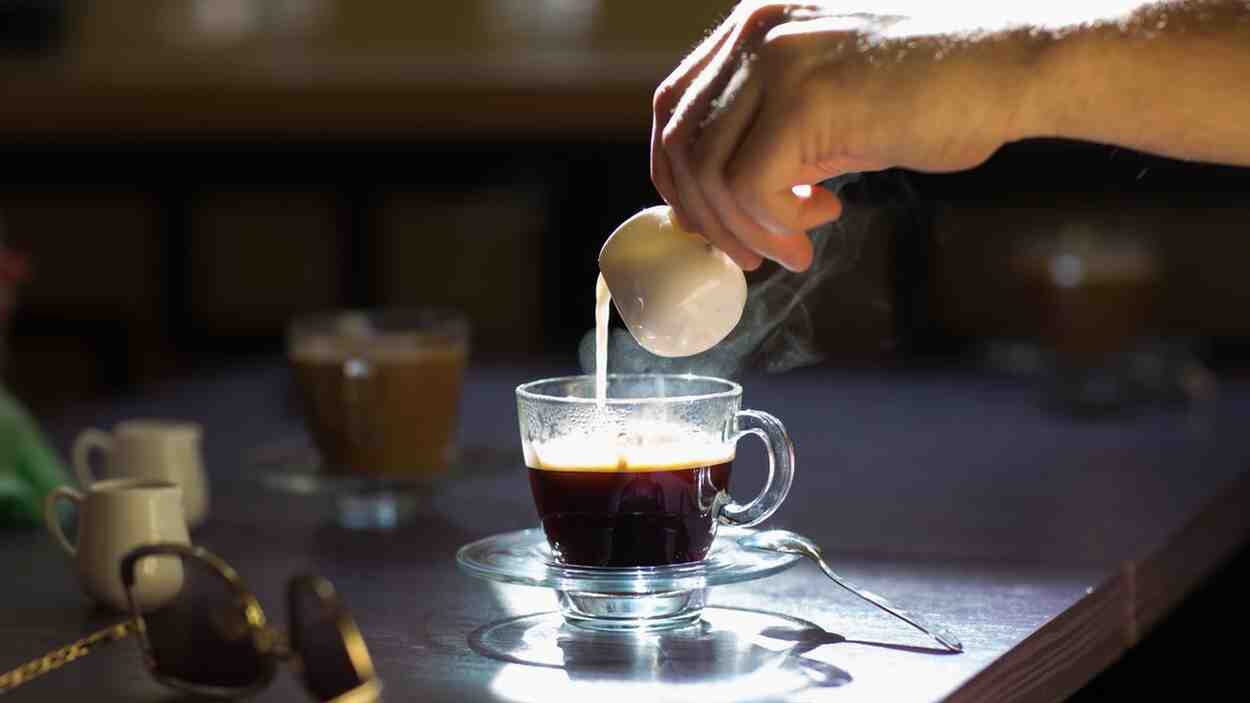Cuban Café Cubano is much more than just a coffee; it represents a cultural experience deeply rooted in Cuban life. This strong, sweet espresso serves as a daily ritual, bringing people together. It is a way to connect during mornings, after meals, and during social gatherings. The preparation of Café Cubano may seem simple, yet it holds great significance in Cuban communities, particularly in Miami, where the tradition remains strong.
What is Café Cubano?
Understanding Café Cubano
Café Cubano, also known as Cuban espresso, combines the intense strength of espresso with the sweetness of espumita. This creamy, frothy foam forms on top, adding a distinct flavor and smooth texture to each sip. It differs from other espresso styles due to its preparation and sugar integration.
- Key Ingredients:
- Freshly ground espresso beans.
- Sugar, often raw cane sugar for richer flavor.
- Water, crucial for extracting the coffee.
- Signature Feature: The espumita makes Café Cubano stand out. It results from whipping sugar with the first drops of brewed coffee, creating a caramel-like foam that balances the bitterness of espresso. This step is what gives the drink its signature sweetness and velvety texture.
- Serving Size: Traditionally, Café Cubano is served in small espresso cups, known as tacitas. These small portions ensure that each sip is packed with flavor, allowing the rich taste to be enjoyed slowly.
Origins and History of Café Cubano
The history of Café Cubano is tied closely to Cuba’s deep-rooted coffee culture. Coffee arrived in Cuba during the 18th century, introduced by French colonists. By the 19th century, Cuba had become a major coffee producer, exporting beans to Europe. As coffee became a staple, unique brewing methods developed, giving rise to what is now known as Café Cubano.
- Early Coffee Culture in Cuba: Coffee plantations thrived in regions like Sierra Maestra and Pinar del Río. Cities such as Havana and Santiago de Cuba saw the emergence of cafes, where locals gathered to enjoy strong, black coffee.
- Italian Influence: In the early 20th century, Italian immigrants introduced espresso machines to Cuba. Cuban baristas quickly adapted these methods, adding sugar to cater to local tastes.
- Havana’s Role: Havana’s bustling coffee scene helped spread the popularity of Café Cubano. Cafes became meeting points where people discussed politics, art, and everyday life over a shared colada (a larger batch of Café Cubano meant for sharing).
This evolution turned Café Cubano into more than just a beverage. It became a symbol of community, resilience, and Cuban creativity.
How to Make Authentic Café Cubano
Traditional Café Cubano Recipe
Making an authentic Café Cubano at home is simple, yet it requires attention to detail. The goal is to achieve the perfect balance between strong espresso and the sweet, frothy espumita. Follow this guide for the best results:
- Ingredients:
- 2 tablespoons of finely ground dark roast coffee.
- 1 tablespoon of sugar (raw cane sugar preferred).
- 1 cup of water.
- Equipment:
- Moka pot or espresso machine.
- Small bowl and whisk.
- Small espresso cups (tacitas).
- Step-by-Step Method:
- Prepare the Moka Pot: Fill the bottom chamber with water up to the safety valve.
- Add Coffee Grounds: Place the coffee in the filter basket, leveling it gently without pressing down.
- Brew the Coffee: Assemble the Moka pot and place it over medium heat. Capture the first drops of coffee to make the espumita.
- Create the Espumita: Combine sugar with the first drops of coffee in a small bowl. Whisk briskly until a thick foam forms.
- Combine and Serve: Pour the remaining coffee over the espumita, stirring gently. This creates a frothy layer on top.
- Serve in Small Cups: Pour into tacitas and enjoy while hot.

Tips for the Best Espumita
- Use the First Drops: The initial drops are the richest, making them ideal for a thick espumita.
- Whisk Quickly: Fast whisking results in a stable, dense foam.
- Adjust Sugar: While Café Cubano is traditionally very sweet, you can modify the sugar level to match your preference.
Variations of Café Cubano
Café Cubano has inspired several popular variations, each offering a unique twist:
- Café con Leche: A mix of Café Cubano with steamed milk, perfect for breakfast.
- Colada: A larger serving of Café Cubano meant for sharing, often accompanied by small cups.
- Cortadito: Combines a shot of Café Cubano with a splash of steamed milk, balancing strength with creaminess.
These variations highlight Café Cubano’s versatility and role in social gatherings.
The Role of Café Cubano in Cuban Culture
Café Cubano as a Social Ritual
In Cuba, Café Cubano is more than just a drink—it’s a social tradition. It plays a significant role in daily routines and gatherings:
- Morning Ritual: Many Cubans start their day with a shot of Café Cubano, either at home or at a local café. It energizes and prepares them for the day.
- Community Connection: Offering Café Cubano to a guest is a gesture of friendship. Neighbors often gather for a chat over a shared cup.
- Celebrating Together: Café Cubano marks moments of joy, from birthdays to casual get-togethers, strengthening the bonds between family and friends.
Café Cubano’s Cultural Significance
For many Cubans, Café Cubano remains a symbol of cultural pride. It provides a link to their heritage, especially for those living abroad:
- Symbol of Home: Drinking Café Cubano offers a sense of nostalgia and connection to Cuba’s traditions.
- Preserving Heritage: Passing down the art of making Café Cubano helps maintain cultural identity. It keeps younger generations connected to their roots.
- Resilience and Comfort: Even in difficult times, Café Cubano offers comfort. It serves as a reminder of Cuba’s enduring spirit.
The Global Reach of Cuban Café Cubano
Café Cubano’s popularity extends beyond Cuba, captivating coffee enthusiasts around the world. Its bold, sweet flavor and rich cultural significance have made it a staple in Cuban-American communities, especially in Miami. Furthermore, the straightforward preparation method, paired with the unique sweetness of espumita, has attracted a global following. This mix of tradition and flavor makes Café Cubano a beloved choice among coffee lovers.
The Secrets Behind the Perfect Café Cubano
The Role of Sugar
Sugar plays a crucial role in making Café Cubano, especially in creating the espumita. Unlike many sweetened coffees, Café Cubano blends sugar directly with espresso, resulting in a rich, frothy layer. Here’s why sugar is essential:
- Creating the Espumita: Whisking sugar with the first drops of coffee forms a thick, sweet foam. This step caramelizes the sugar slightly, enhancing the flavor.
- Balancing Bitterness: The sweetness softens the dark roast’s natural bitterness, making each sip smooth.
- Customizing Sweetness: While traditionally sweet, you can adjust sugar levels to fit your taste.
Choosing the Right Beans
Selecting the best coffee beans is crucial for a great Café Cubano. Here’s what to look for:
- Dark Roast: It’s the traditional choice, providing bold flavors that pair well with the sweet espumita.
- Single-Origin Beans: Those from Colombia or Brazil often have chocolate and nutty notes.
- Freshly Roasted: Using beans within two weeks ensures vibrant flavors.
Tasting and Enjoying Café Cubano
Flavor and Aroma
Café Cubano’s rich taste is known for its bold and sweet profile. It offers:
- Depth and Richness: The coffee’s bold flavor is balanced by the caramel-like sweetness.
- Smooth Texture: The espumita creates a velvety finish.
- Lingering Sweetness: Notes of molasses and caramel stay on the palate.

Café Cubano in Miami and Beyond
Café Cubano has become a cultural icon in Miami, where it is integral to the lives of Cuban-Americans. It embodies a taste of home, offering comfort and familiarity in a new environment. Miami’s coffee scene reflects the traditions of Havana while adapting to American tastes. The cultural significance of Café Cubano resonates throughout the city, making it a favorite for both locals and tourists.
Miami’s Role in Preserving Tradition
- Little Havana’s Cafes: Cafes in Miami’s Little Havana serve Café Cubano just like in Cuba. These establishments are not only coffee shops; they are community hubs where people gather, share stories, and connect over a shared colada.
- Influencing Local Trends: The popularity of Café Cubano has shaped the broader coffee culture in Miami. It has inspired other shops to adopt Cuban espresso methods, blending them with modern techniques.
- Adapting to New Markets: Some cafes in Miami have innovated by offering variations like iced coladas and flavored cortaditos. These adaptations cater to a wider audience while maintaining the essence of the traditional recipe.
The Rise of Café Cubano in Specialty Coffee Shops
Beyond Miami, Café Cubano has gained recognition in specialty coffee shops worldwide. Its rich flavor and unique preparation have caught the attention of coffee connoisseurs. Here’s how it has influenced the global coffee scene:
- Adoption by Specialty Cafes: Many specialty coffee shops outside of Cuban communities have embraced Cuban-style espresso. They highlight traditional methods, using high-quality beans to bring out the best flavors in Café Cubano.
- Adding a Modern Twist: Baristas often experiment with Café Cubano, introducing flavors like vanilla or cinnamon. These twists attract those who seek a new experience while staying true to the original’s essence.
- Educating Coffee Enthusiasts: Specialty cafes emphasize the significance of the espumita and the proper use of a Moka pot. By sharing the story behind Café Cubano, they help preserve its authenticity and introduce it to a broader audience.
Tips and Notes for Brewing the Perfect Café Cubano at Home
Making Café Cubano at home can be both enjoyable and rewarding. With the right technique, you can recreate the traditional Cuban experience in your kitchen. Here are some essential tips to help you master the process:
| Tip | Explanation |
|---|---|
| Use Fresh, High-Quality Beans | Freshly roasted beans deliver a richer flavor. |
| Whisk Sugar with First Drops | This step ensures a creamy and dense espumita. |
| Invest in a Moka Pot | A Moka pot closely replicates the traditional Cuban brewing method. |
| Adjust Grind Size | A fine grind is best for espresso, but small adjustments can enhance flavor balance. |
| Monitor the Heat | Brewing over medium heat prevents the coffee from tasting burnt. |
| Clean Your Equipment Regularly | Keeping your Moka pot clean ensures consistent flavor in each brew. |
| Customize the Sweetness | Adjusting the amount of sugar lets you find the perfect balance for your taste. |
These tips will help you achieve a well-balanced Café Cubano, allowing you to enjoy the rich taste of this traditional coffee at home.
The Future of Café Cubano
Balancing Tradition with Modern Trends
As coffee culture continues to evolve, Café Cubano remains relevant by staying true to its roots while adapting to new preferences. The challenge lies in balancing tradition with innovation. Cuban cafes and families strive to maintain the authenticity of their methods, ensuring that the essence of Café Cubano remains intact.
- Maintaining Traditional Methods: In many Cuban households, the process of making Café Cubano has not changed. Families teach younger generations the importance of creating a proper espumita, passing down this knowledge to preserve the cultural heritage.
- Innovating for New Audiences: While tradition is respected, there is also room for creativity. Baristas have introduced new takes on Café Cubano that appeal to modern tastes. Iced versions and unique flavor infusions are just a few examples of how this classic drink evolves.
Café Cubano’s Influence on Global Coffee Culture
Café Cubano’s impact extends well beyond Cuban-American communities. Its emphasis on simplicity, rich flavor, and cultural roots has made it a favorite among those who appreciate handcrafted coffee. Here’s how it continues to shape global coffee trends:
- Inspiring a Mindful Approach: The careful preparation of Café Cubano encourages a slower, more thoughtful way of making coffee. This focus on process over speed aligns with the values of the third-wave coffee movement, where quality is prioritized.
- Expanding Internationally: As more people discover the unique taste of Café Cubano, it has found a place in coffee shops worldwide. Its distinctive flavor profile and cultural backstory make it a standout choice for those seeking something new.
- Connecting Cultures: Café Cubano bridges cultural gaps by offering a taste of Cuba’s heritage. It invites coffee lovers to explore the rich history behind each cup, fostering a deeper appreciation for Cuban traditions.

